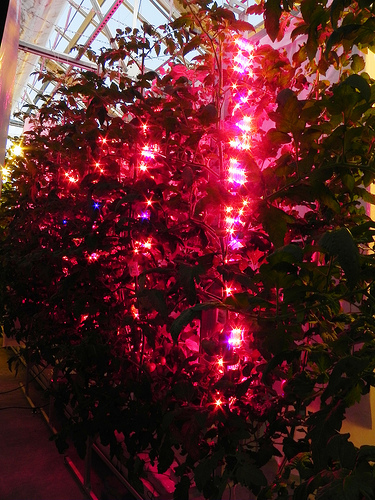A recent U.S. Department of Agriculture blog entry introduces Purdue University's research resulgs on LED grow lights. Banks of LED illuminate plants in greenhouses. Purdue University researchers discovered that LEDs can provide a more beneficial light spectrum to greenhouse plants than conventional lighting while using 75 percent less electricity.
 |
|
Banks of LED illuminate plants in greenhouses. Purdue University researchers discoverd LEDs can provide a more beneficial light spectrum to greenhouse plants than conventional lighting while using 75% less electricity. (Courtesy of Celina Gomez) |
This post is part of the Science Today feature series on the USDA blog. Check back each week as we showcase stories and news from USDA’s rich science and research portfolio.
For about 2,000 years – since Roman emperor Tiberius demanded fresh cucumbers for lunch year ‘round – farmers have been looking for better ways to extend the growing season. Now, a team of researchers led by Purdue University has found a way to grow more produce and save money doing it.
Greenhouses and other structures protect crops from harsh environmental conditions. Over the last 50 years or so, some growers have added artificial lighting to compensate for shorter winter days or when conditions are cloudy. However, the problem with most lighting systems is that they are relatively costly to install and do not provide the light spectrum that is most efficient for photosynthesis in plants.
The Purdue-led team of academic and industry scientists from Wisconsin, Michigan, and New Jersey is using grant funding from the U.S. Department of Agriculture’s National Institute of Food and Agriculture (NIFA) to investigate the use of LED to address this problem. The researchers have designed LEDs that produce the exact light quality plants need to thrive while using only a fraction of the electricity used by high-pressure sodium lamps—the current industry standard. In experiments in West Lafayette, IN, the team’s LED systems used 75 percent less electricity to produce the same product yield. There are currently about 4,200 acres of greenhouses in the United States that use supplemental lighting. If LED systems were installed in each of these greenhouses, energy use could be reduced by 3.5 billion kilowatt hours. According to the U.S. Environmental Protection Agency, a reduction of that much energy would reduce carbon dioxide emissions by almost 3 million tons per year.
Through federal funding and leadership for research, education, and extension programs, NIFA focuses on investing in science and solving critical issues that impact people’s daily lives and the nation’s future.












